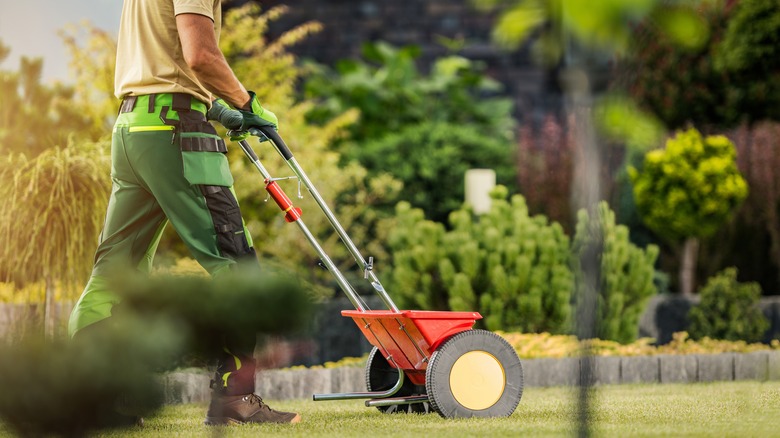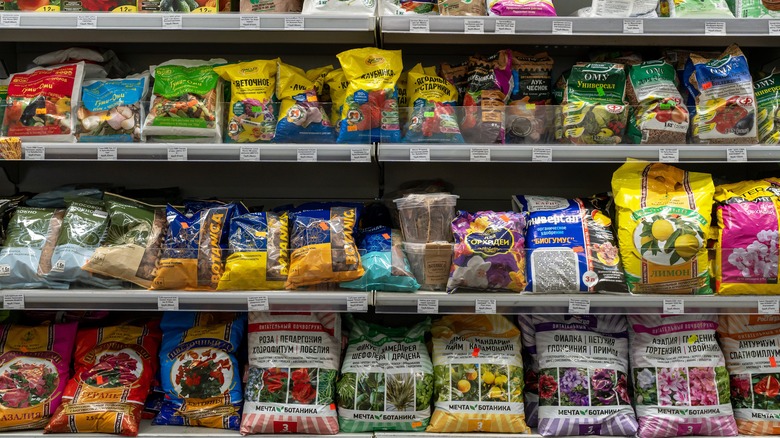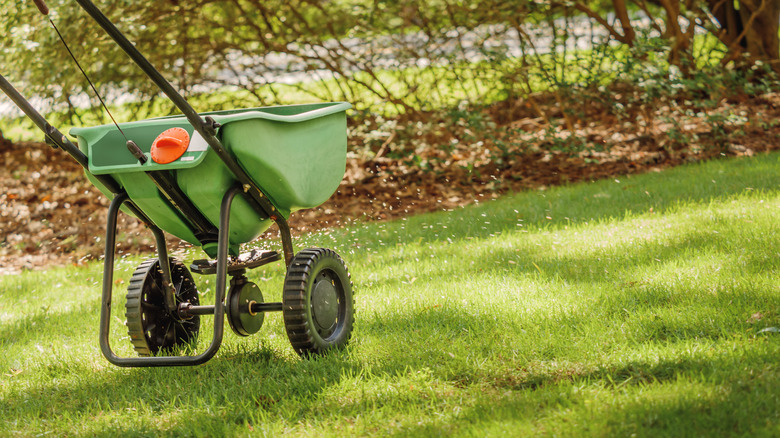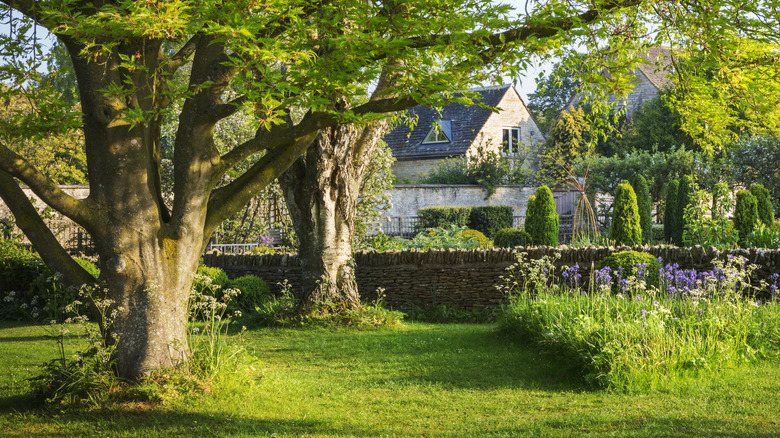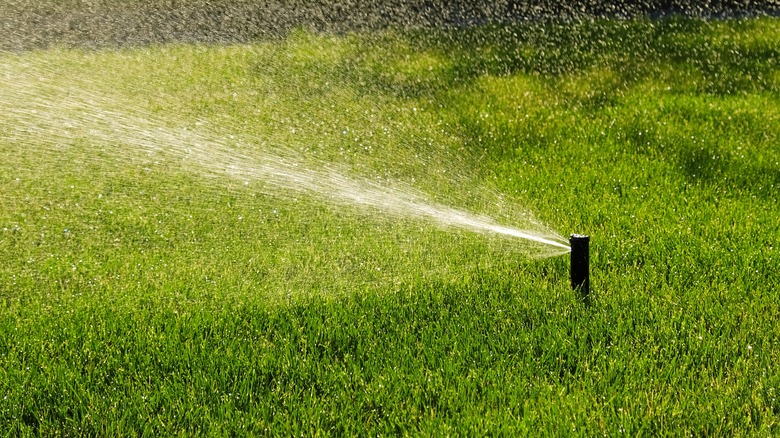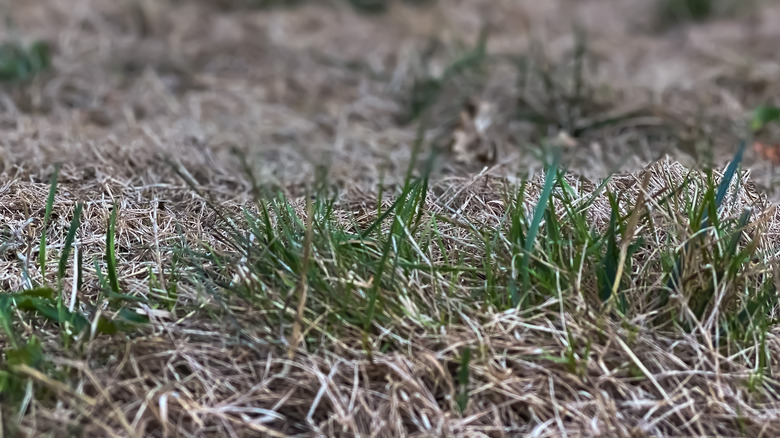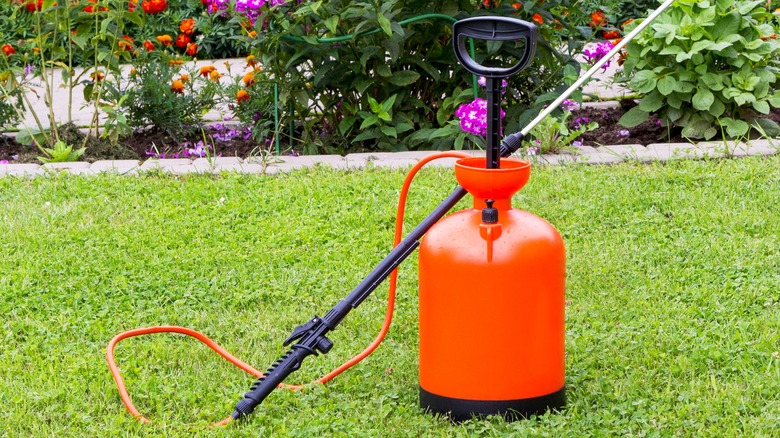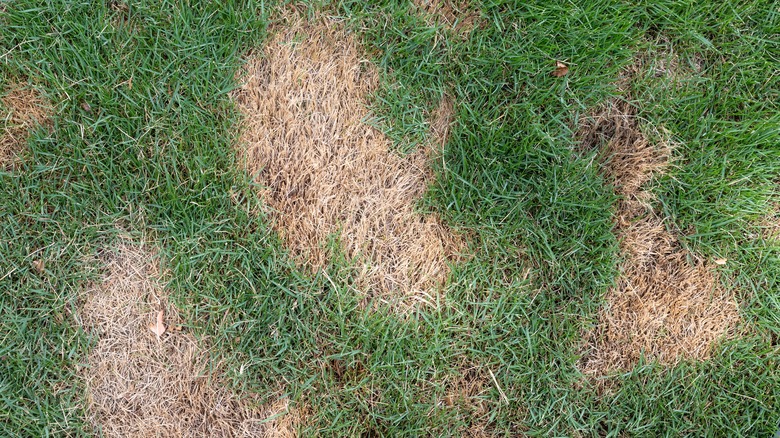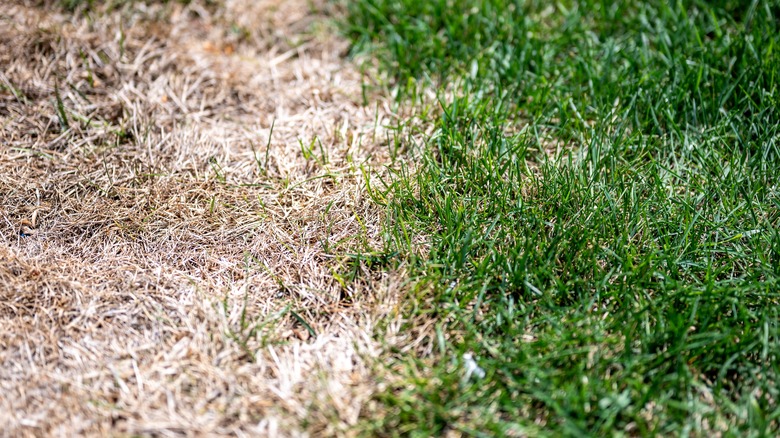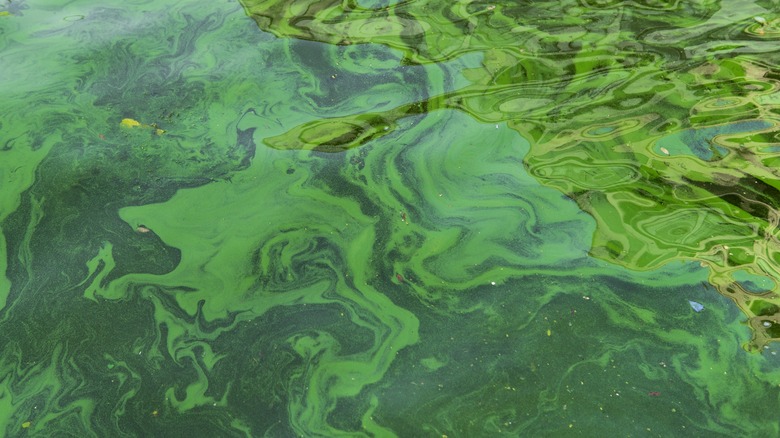Things You Should Never Do When Fertilizing Your Lawn
We may receive a commission on purchases made from links.
If you want a luscious bright green lawn, you probably already know that fertilizing it is essential. Lawn fertilizer promotes new growth that can make it feel like a cushioned carpet of grass is underfoot, and it elevates the color of the blades to a shade that will make your neighbors green with envy (although probably not as green as your lawn!) Fertilizer also offers health advantages for lawns. For example, it allows grass to repair itself and helps block weeds from emerging. However, to keep your lawn in tip-top shape there are several things you should avoid when using fertilizer. To figure out what that exactly is, we turned to expert Brian Clayton, the CEO of GreenPal.
The dos and don'ts of using fertilizer on your lawn are super simple once you gain an understanding of how it works and the effects it has on your grass. This knowledge is key to ensuring your lawn remains healthy and attractive because minor mistakes, such as feeding the lawn at the wrong time of year or forgetting to water it after an application, can cause significant issues. Other things you need to be aware of, like the local laws surrounding fertilizer use in your state, could cost you a fortune if you inadvertently get them wrong. As Clayton told House Digest in an exclusive interview, "Fertilizing isn't rocket science, but getting it wrong can do more harm than good. Keep it simple, and your turf will thank you."
Don't ignore the numbers on the fertilizer bag
Have you ever wondered what the numbers on the front of a fertilizer bag indicate? No, this is not the fertilizer's birthday; it is the ratio of nutrients in the formula. Clayton says you need to match these numbers to the time of year for the best growth. He explains, "In spring, you want more nitrogen to promote growth. In summer, ease up on nitrogen to avoid stressing the turf. In fall, a bit more nitrogen helps prepare the lawn for winter. Ignoring this can lead to an unhealthy lawn."
Ignoring the numbers on the fertilizer bag cannot only mean your lawn isn't reaching its full growing potential, but it can also harm it. To ensure your lawn is getting the right nutrients at the right time, you need to gain an understanding of what these numbers mean so you can decide which fertilizer is best for your lawn at different times. Fertilizer nutrients are always explained in the same format: N-P-K. 'N' represents nitrogen, which focuses on making bladed green and thick, 'P' represents phosphorus, which focuses on root growth, and 'K' represents potassium, which improves things like disease-resistance and drought tolerance. A typical N-P-K might look like '4-2-2', which means the fertilizer is higher in nitrogen with equal levels of phosphorus and potassium. Use fertilizers containing more nitrogen in the spring and fall, and less nitrogen in summer.
Don't fertilize too late in the summer
Traditionally, many gardeners fertilize their lawns in fall because they believe it helps the grass to remain healthy and survive the colder weather conditions through winter. However, this isn't always the case. While some lawns can handle fall fertilization, most should be left alone after early summer. The Royal Horticultural Society advises against fertilizing lawns any later than August. The reason is simple: Fertilizers stimulate new green growth, and when this happens too late in the year, the tender shoots become susceptible to pests, disease, and damage from low temperatures.
Anyone growing warm-season grass, specifically, should avoid using a lawn fertilizer that contains nitrogen in late summer or early fall since this puts the lawn at risk of injury. You will know if you have warm season grass because it actively grows in the summer months and goes brown and dormant through winter. In contrast, cool season grass turns brown if temperatures reach over 85 degrees Fahrenheit. The exception to this rule is if you have purchased some nitrogen-free fertilizer. Nitrogen is the nutrient that encourages green growth, so using a fertilizer with no nitrogen in it can be suitable in the fall. Opt for a fertilizer formula that is high in potassium, as this can be beneficial in helping the lawn become more winter-hardy. Interestingly, there are also negative consequences to fertilizing your lawn too early in the season, so it's important to understand the effects of this product before you apply it and regret it afterward.
Don't fertilize too close to trees and large shrubs
If your lawn has trees and shrubs growing among it, you'll need to be careful when applying fertilizer. You'll need to consider not only the health of your lawn, but also the health of these plants. When fertilizer comes into contact with the trunk of a tree or the main stems of shrubs, it can cause injury. The root collar and trunk base area of a tree are particularly susceptible to fertilizer burn, and these types of injuries weaken the tree and make it easy for pests or diseases to take hold.
To avoid causing injury to your trees and large shrubs, The University of Tennessee advises placing the fertilizer at least 1 foot from the trunk of small trees, and 18 inches of the trunk of large trees. This means you effectively need to create a measured circle around the base of your trees with either a 24-inch or 36-inch diameter, where lawn fertilizer is not applied. Don't be fooled into thinking that organic fertilizers can safely be used close to tree trunks, because these naturally-sourced products also contain lots of salt, which can burn trees and shrubs.
Don't forget to water after fertilizing
Watering your lawn after feeding is an essential step in the fertilizing process. This helps the nutrients soak into the soil where they can be readily available for the grass roots to absorb, and it also helps to prevent fertilizer burn. Clayton explains, "If you skip this step, you risk the fertilizer sitting on the grass blades and burning them, especially in hot weather." Most fertilizers indicate on their packaging how much water you should apply to the lawn after an application. Try to follow this advice as closely as possible for the best results.
Burning is a common result of fertilizer being applied in dry conditions, so watering your lawn after a feed is crucial. However, you also need to be mindful of overwatering. When too much water is applied after feeding, the nutrients from the fertilizer are at risk of leaching into local waterways via runoff. This can cause water pollution that is dangerous to underwater creatures and the ecosystem they live in. Using a slow-release fertilizer can help manage this risk.
Don't fertilize during a drought
Lawns should not be fertilized during a drought because this encourages rapid growth of new tender blades, which will be harmed by the lack of moisture. Nitrogen-high fertilizer in particular should be avoided because this causes the lawn to direct its efforts on growth over roots, denying the lawn the opportunity to grow hardy roots it will need to withstand drought and other adverse conditions. Clayton backs up this argument, recommending that homeowners hold off on fertilizing a dry lawn. He explains, "If your lawn is dry and you don't have a solid irrigation system or aren't diligent with watering, hold off on fertilizing. Applying fertilizer during a drought can stress and burn the turf, making things worse. Instead, wait until you've had some consistent rain or your irrigation system is up and running."
Though it's best to pass on the fertilizer during a drought, you can use it to prepare a lawn to better survive during dry spells. Do this using a fertilizer that is high in potassium, making sure to water the fertilizer in to reduce the chance of root burn. If you want to keep your lawn looking green and lush during a drought, apply supplemental iron instead of fertilizer. This can help the turf look healthy without encouraging new growth. If you insist on fertilizing during a drought, opt for a formulation that offers slow-release nitrogen and phosphorous. This will reach the plant slowly, minimizing the risk of burn or growth.
Don't 'weed and feed'
Weed and feed products contain herbicides and fertilizer to conveniently prevent or kill weeds while feeding the lawn in one simple application. They have become a popular garden product based on their ease of use, but many professional landscapers have identified reasons why you shouldn't weed and feed your lawn. In most cases, weed killers and fertilizers work best when they are applied at different times of the year. Herbicide for broadleaf weeds works best when applied in the fall because at this time the weeds are focusing on using all of their energy and resources on their roots, carrying the herbicide along for the ride where it will be more effective at killing the plant. However, if you fertilize in the fall, it could cause more harm than good. To kill off weed seeds before they emerge, February or March is the best time to apply a herbicide. However, this is also an ineffective time to fertilize the lawn, once again indicating that a combined dose of weed and feed is not ideal.
The best way to treat your lawn for weeds and keep it healthy with a fertilizer is to use two separate products and apply these at the most appropriate times of year. Use a broadleaf herbicide in fall to target weeds such as dandelions as they are beginning to save energy for winter, and a pre-emergent herbicide in late winter to stop any weed seeds in their tracks before they have a chance to emerge. The right time to fertilize a lawn will depend on your local climate and the type of grass you are growing, but typically, you should start with a spring application in late May.
Don't apply fertilizer unevenly
Uneven fertilizer application can lead to a patchy, unattractive lawn. In areas where fertilizer has been applied your lawn may look lush and thriving, while areas that have been missed could look sparse or appear a paler, duller shade of green. In some instances, if too much fertilizer is applied in one application, the soluble salts can cause the roots to burn, resulting in brown patches of grass.
Clayton agrees that uneven fertilizer application can lead to patchy growth. His professional recommendation? "Use a broadcast spreader and make sure you cover the entire lawn evenly to avoid this." Broadcast spreaders, like this one from Amazon, are one of the lesser-known lawn tools you'll wish you had sooner. They can help to ensure consistent coverage, and they can hold large amounts of product so you can feed your garden in one easy application. They are also multi-functional because they can work with other products besides fertilizer. Fill them with grass seed when you're seeding your lawn, or salt when you need to melt ice on your driveway in winter. If you do make the mistake of applying feeding product too heavily in some areas, all is not lost. You can save your lawn after over-fertilizing by quickly watering it to reduce the concentration of nutrients available in the soil.
Don't over-fertilize
Can you over-fertilize your lawn? Well, according to some lawn product manufacturers, more is better. However, over-feeding your lawn is actually detrimental to its overall health. Clayton explains, "Fertilization companies might try to sell you on eight or nine applications a year, but that's overkill. Too much fertilizer can lead to excessive growth, which weakens the grass and makes it more susceptible to disease." Not only can excess feeding products undermine your lawn's health, but if you're using artificial fertilizer then you could be causing harm to the environment. The Royal Horticultural Society recommends limiting artificial fertilizer applications to the minimum amount required for this reason.
The minimum amount of times you can fertilize your lawn will depend on a variety of factors. For example, older lawns that are well established will need less fertilizer than newer lawns to remain healthy, and the area you live in and the type of soil you have can also come into play. In some cases, you may get away with just one application of fertilizer each year, but for most of us, an application in spring and fall is needed to get the lush look of a green, dense carpet. Clayton suggests a maximum of five applications each year to avoid the negative impacts of over-fertilizing. If you're concerned about the amount of times you are fertilizing your lawn, a good trick is to leave your grass clippings behind rather than sweeping them up. This returns nutrients and can cut the need for fertilizer by 50%.
Don't ignore lawn fertilizer laws
If fertilizers get into local waterways, they can pose a serious risk to wildlife. Fertilizer runoff results in the increased growth of algae, which in turn blocks light from reaching underwater plants that are crucial for maintaining oxygen levels in the water. Ultimately, fertilizer runoff causes the death of fish and other underwater creatures, and it can pose serious health risks if it reaches sources of drinking water. As a result, many states such as New Hampshire, Maryland, New Jersey, Pennsylvania, New York, and Virginia are enforcing fertilizer laws that dictate when and where fertilizers can be used. The laws vary by state, but typically they include a ban on applying lawn fertilizer throughout the winter, too close to bodies of water, or on hard surfaces such as driveways.
You'll need to be aware of any fertilizer laws in your state before you feed your lawn to avoid being faced with a warning or a fine. You can find a lot of the information online, or inquire locally with the relevant department in your town or city. The specifics of fertilizer laws can vary, and if you get caught out you could stand to pay a penalty of up to $2000. For example, in Maryland, the fertilizer law bans lawn fertilizers from being used from November 15 through to March 1, while in Pennsylvania the banned dates for applying it run from December 15 to March 1.
